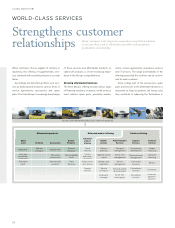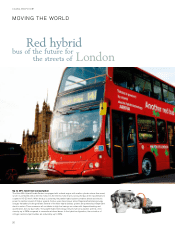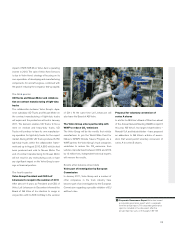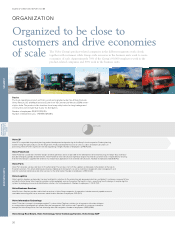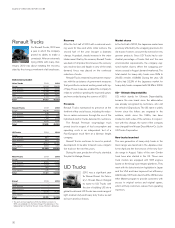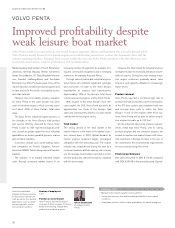Volvo 2010 Annual Report Download - page 31
Download and view the complete annual report
Please find page 31 of the 2010 Volvo annual report below. You can navigate through the pages in the report by either clicking on the pages listed below, or by using the keyword search tool below to find specific information within the annual report.
3% (4) 3% (4)20% (16)8% (8) 3% (5)
Business Units
The business units are organized globally and
combine expertise in key areas. They have the
overall responsibility for product planning and
purchasing and for developing and delivering
components, subsystems, services, and service
and support to the Group’s business areas. The
structure creates economies of scale in product
Buses
has a product range comprising
city and intercity buses, coaches
and chassis.
Number of employees: 7,665
(8,095).
Number of delivered
buses: 10,229 (9,857).
Construction Equipment
manufactures equipment for
construction applications and
related industries.
Number of employees: 13,599
(13,456).
Number of machines sold:
66,000 (38,800).
Volvo Penta
offers engines and drive systems
for leisure and commercial boats
and for industrial applications such
as gensets and materials handling.
Number of employees: 1,211
(1,358).
Delivered marine and industrial
engines: 51,588 (44,983).
Volvo Aero
offers advanced components for
aircraft engines and space appli-
cations with a focus on light-
weight technology for reduced
fuel consumption.
Number of employees: 2,863
(2,991).
Volvo Financial Services
Conducts operations in customer
and dealer financing.
Number of employees: 1,235
(1,234).
Total assets: SEK 89 billion (99).
development, production, parts supply, logistics,
administration and support functions.
In addition to the business units in the over-
view below, there is Volvo Technology that
de velops new technology and new concepts for
products and services in the transportation and
automotive industries. Volvo Group Real Estate
conducts property management and develop-
ment. Volvo Technology Transfer invests in com-
panies with projects of technical and commercial
interest. Volvo Group NAP (Non-Automotive Pur-
chasing) is a global procurement organization
sourcing the goods and services that are
not used in the manufacturing of the Group’s
products.
27



